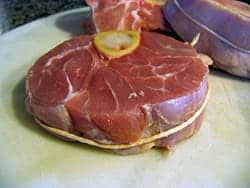Osso Buco
by
Derek Farwagi
Equipment
- cooking twine to tie up shanks
Ingredients
Osso Bucco
- 2 Similar sized veal shanks
- ¼ cup All-purpose flour for dredging
- Coarse salt and freshly ground black pepper
- 2 tbsp Olive oil
- 1 tbsp Butter
- ½ Yellow onion finely chopped
- 1 Medium carrot, diced into 1/4-inch pieces
- 1 Celery stalk with leaves, diced into 1/4-inch pieces
- 1 tbsp Tomato paste
- 3 Garlic cloves, finely chopped
- 3-4 Sprigs fresh thyme (or 1 tsp. dried)
- 1 Bay leaf
- 1 Sprig rosemary ( or 1 tbsp dried)
- 2 strips orange zest, removed with a vegetable peeler (each about 3 inches by ¾-inch)
- 1 cup dry white wine or dry white vermouth
- ½ cup chicken stock
- ½ cup Canned diced tomatoes
Gremolata
- 1 Grated lemon zest
- 1 tspn Finely chopped garlic
- 3 tbsp Finely chopped flat-leaf parsley
Instructions
- Heat the oven to 300 degrees.
- If your butcher has not done so, tie the shanks with twine so that they keep their shape while cooking.
- Dredging the shanks: pour the flour into a shallow dish (a pie plate works nicely). Season the veal shanks on all sides with salt and pepper. One at a time, roll the shanks around in the flour coat, and shake and pat the shank to remove any excuses flour. Discard the remaining flour.
- Browning the shanks: put the oil and 1 tablespoon of the butter in a wide Dutch oven or heavy braising pot (6 to 7 quart) and heat over medium-high heat. When the butter has melted and the oil is shimmering, lower the shanks into the pot, flat side down. Brown the shanks, turning once with tongs, until both flat sides are well caramelized, about 5 minutes per side. If the butter-oil mixture starts to burn, lower the heat a little.
- Transfer the shanks to a large platter or tray and set aside. (Shanks shrink when they are cooked so make sure the twine around each shank has not slipped and is still tight around the meat. If not add another piece of twine around the shanks).
- Pour off and discard the fat from the pot. Wipe out any burnt bits with a damp paper towel, being careful not to remove any delicious little caramelized bits. Add the remaining 1 tablespoon butter to the pot and melt it over medium heat. When the butter has stopped foaming, add the onion, carrot and celery. Season with salt and pepper, stir, and cook the vegetables until they begin to soften but do not brown, about 6 minutes. Stir in the garlic, orange zest, herbs and tomato paste and stew for another minute or two.
- The braising liquid: add the wine, increase the heat to high, and bring to a boil. Boil, stirring occasionally, to reduce the wine by about half, 5 minutes. Add the stock and tomatoes, with their juice, and boil again to reduce the liquid to about 1 cup total, about 10 minutes.
- The braise: Place the shanks in the braising liquid so that they are sitting with the soft bone marrow facing up, and pour over any juices that accumulated as they sat. Cover tightly with the lid, and slide into the lower part of the oven to braise at a gentle simmer. Check the pot after the first 15 minutes, and if the liquid is simmering too aggressively, lower the oven heat by 10 or 15 degrees. Continue braising and occasionally spooning some pan juices over the top until the meat is completely tender and pulling away from the bone, about 2 hours.
The gremolata
- While the shanks are braising, stir together the finely chopped garlic and parsley with the lemon zest in a small bowl. Cover with plastic wrap and set aside.
The saffron Risotto OR Polenta
- While the shanks are braising, make the risotto or polenta. For the risotto recipe see https://amediterraneangourmet.com/saffron-risottoFor the polenta recipe see https://amediterraneangourmet.com/polenta/
Finish the Osso Bucco
- When the veal is fork-tender and falling away from the bone, use a slotted spatula or spoon, carefully lift the shanks from the braising liquid, doing your best to keep them intact. The shanks will be very tender and threatening to fall into pieces. Arrange the shanks on a serving platter, using scissors remove the string and cover with foil to keep warm.
- Finishing the sauce: Set the braising pot on top of the stove: if there is a visible layer of fat floating on the surface, use a large spoon to skim it off and discard it. Taste the sauce for concentration of flavor. If it tastes a bit weak or flat, bring it to a boil over high heat, and boil to reduce the volume and intensify the flavor for 5 to 10 minutes. If it it is too concentrated, add a little chicken stock. Taste again for salt and pepper.
- Serving: Arrange the veal shanks on warm dinner plates accompanied by the risotto or polenta. Spoon over a generous amount of sauce and garnish with Gremolata.
Notes
Osso Buco (without the Gremolata) can be made a day ahead. Allow to cool completely then chill. Reheat covered over a low fire for about 20 minutes.
Tried this recipe?Tried this recipe? Let me know how it turned out.
